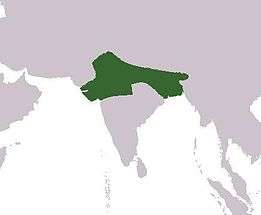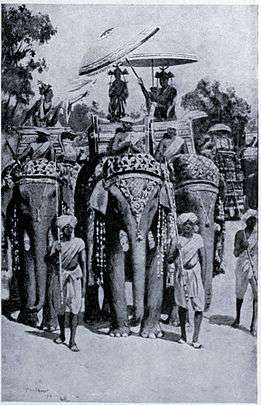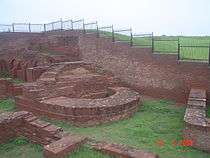Empire of Harsha
| Empire of Harsha | |||||
| हर्षवर्धन | |||||
| |||||
 The Empire of Harsha at its greatest extent | |||||
| Capital | Kannauj | ||||
| Religion | Buddhism Hinduism Jainism | ||||
| Government | Monarch | ||||
| Emperor | |||||
| • | 606–647 | Harsha | |||
| Historical era | Ancient India | ||||
| • | Established | 606 | |||
| • | Disestablished | 647 | |||
The Empire of Harsha was an ancient Indian empire founded and ruled by Emperor Harsha from the capital Kannauj. It existed from 606 to 647 and at its height covered all of the North India. Although the empire was short-lived, the peace and prosperity that prevailed made the court of Harsha a center of cosmopolitanism, attracting scholars, artists and religious visitors from far and wide, such as the Chinese traveler Huien-Tsang
Background
Prabhakarvardhana, the ruler of Thanesar, who belonged to the Pushyabhuti family, extended his control over neighbouring states.
Rajyashri, the sister of Rajyavardhana and Harsha, had married the Maukhari king, Grahavarman, whose capital was at Kannauj. Some time later, Grahavarman was killed by the ruler of the Malava kingdom, who also kidnapped Rajyashri. Rajyavardhana, who had succeeded his father as king at Thanesar, marched against the Malava king and defeated him. Around 606 CE, Rajyavardhana died, perhaps murdered at a meeting by Shashanka, ruler of the Gauda kingdom.[lower-alpha 1] It was after the death of Rajyavardhana that Harsha succeeded to the throne.[1][2]
History
The Empire of Harsha revived the past glory of the Gupta Empire in northern India.[3] The economy of northern India prospered and his capital at Kanauj became a great centre of trade.[4] During his early career he possessed a force of 5,000 elephants, 20,000 cavalry and 50,000 infantry and with this he overran northern India. After the conquest of almost the entire of northern India, his military resources were so increased that he could field an army with 100,000 cavalry and 60,000 elephants. His long run of victories was only broken when he was defeated by the south Indian Emperor Pulakesi II of the Chalukya dynasty.[5]
According to Dr. Shreenand L. Bapat, Registrar, Bhandarkar Oriental Research institute, Pune, Pulakeshin II defeated Harsha on the banks of Narmada in the winter of 618-619. His information is based on a copperplate inscription of Pulakeshin II discovered recently.[6][7]
The administration of Harsha was similar to the Gupta Empire. He was just in his administration and punctilious in exercising his responsibilities.[8] There was no forced labour and everyone was free to busy himself with his own affairs.[9] Harsha built for the benefit of the poor throughout his Empire in both the towns and rural parts Rest-Houses which provided food, drink and medicine.[10] Harsha was continually travelling up and down his wide dominions to see with his own eyes how the people were ruled in his Empire.[11] The merchants travelled freely in his Empire and officials were paid regularly.[11] The taxes were light and one-sixth of the land produce was charged as land revenue.[4]
Today a mound 1 km long and 750 m wide known as "Harsh ka Tila" in Thanesar has ruins of structures built during the reign of Harsha. Amongst the archaeological finds from the mound include 'Painted Grey Ware' shreds in the pre-Kushana levels and 'Red Polished Ware' from post Gupta period.[12]
Economy
Economy under the Empire of Harsha became increasingly more locally self-sufficient and feudal in nature as trade and commerce receded. This is reflected in the decline of trade centres, paucity of coins and near complete disappearance of trader and merchant guilds. Diminishing trade and commerce affected handicraft and other industries through want of demand; and affected agriculture although not directly. As a result of the lack of trade, the need to produce agricultural goods for sale externally vanished and people began producing amounts adequate enough to meet their own local needs. This marked the rise of self-sufficiency in the village economy and the growing dependence on agriculture.
Feudalism
When scholars mention Indian feudalism, the Empire of Harsha is usually taken as a typical state. Insight into Harsha's Empire is given by the discovery of a set of plates of copper, dating back to 632 CE, recording the gift of land by a military officer under Harsha's service to two Brahmins. Donations before Harsha's reign had come from either a royal prince or one of the provincial governors. In the copper plates, the first dignitary mentioned was a Mahasamanta, who ruled a territory adjoining Kanauj. But, the donor of the land was a military servant of Kanauj, and the execution of the grant came under Harsha's accounts. This leads to the conclusion that the Mahasamantas were in fact independent rulers with kingdoms near the core area of an overlord - here, King Harsha - and they paid tribute and provided military assistance to him. Though they may have obtained their territories through inheritance or conquest, there were some who served kings and got grants in the form of land to support their official duties; a process similar to distribution of feudal grants in Europe.
Contact with China
Harsha maintained friendly diplomatic relations with China, which was under the rule of Emperor Taizong of the Tang dynasty. Envoys from each country visited the other, most notably the Chinese monk Xuanzang who spent eight years in the Empire of Harsha.
Patron of Buddhism and literature

Harsha's father, Prabhakarvardhana, was from Thanesar, his brother followed Hinayana Buddhism while, according to Bana, Harsha himself was a Mahayana Buddhist. Harsha was a tolerant ruler and supported all Indic faiths – Buddhism, Vedism and Jainism. Early in his life, he seems to have been a follower of Sun Worship, becoming a patron of Shaivism and Buddhism later on.[13]
His sister Rajyashri's conversion to Buddhism presumably had a positive effect on his support to the religion. His approach to religion is evident in his celebrated play Nagananda. The play's theme is based on the Jataka tale of the Bodhisattva Jimutavahana, but Harsha introduces the Goddess Gauri, Shiva's consort, as the saviour of Jimutavahana, a feature not found in the Jataka.
According to the Chinese Pilgrim Xuanzang, who visited his kingdom in 636, Harsha built numerous stupas in the name of Buddha. Xuanzang entered a grand competition organised by Harsha and won the theological debate. Harsha also became a patron of art and literature. He made numerous endowments to the University at Nalanda. Two seals of Harsha have been found in Nalanda in the course of the excavations. All these favours and donations of the great emperor were crowned by the construction of a lofty wall enclosing all the buildings of the university to defend the institution from any other possible attack. In 643 he held a Buddhist convocation at Kannauj which was reputedly attended by 20 kings and thousands of pilgrims.[14]
In 641, following Xuanzang's visit, Harsha sent a mission to China which established the first diplomatic relations between China and India. The Chinese responded by sending an embassy consisting of Li Yibiao and Wang Xuance, who probably travelled through Tibet and whose journey is commemorated in inscriptions at Rajagriha – modern Rajgir, and Bodhgaya.
Harsha was a noted author on his own merit. He wrote three Sanskrit plays – Nagananda, Ratnavali and Priyadarsika. His reign is comparatively well documented, thanks to his court poet Bana in Harschacharita and by Xuanzang in Si-Yu-Ki. Bana composed an account of Harsha's rise to power in Harsha Charitha, the first historical poetic work in Sanskrit language. Xuanzang wrote a full description of his travels in India.[15]
Disintegration

Harsha died in 647, having ruled for 41 years. His empire died with him, disintegrating rapidly into small states. The succeeding period is very obscure and badly documented, but it marks the culmination of a process that had begun with the invasion of the Huns in the last years of the Gupta Empire.
In 648, Tang Taizong sent Wang Xuance to India in response to Harsha sending an ambassador to China. However once in India he discovered Harsha had died and the new king attacked Wang and his 30 mounted subordinates.[16] This led to Wang Xuance escaping to Tibet and then mounting a joint of over 7,000 Nepalese mounted infantry and 1,200 Tibetan infantry and attack on the Indian state on June 16. The success of this attack Wang Xuance the prestigious title of the "Grand Master for the Closing Court."[17] He also secured a reported Buddhist relic for China.[18]
See also
References
Notes
- ↑ The claim of murder is dubious because the only sources for it are Banabhatta and Hiuen-Tsang, who differ in their accounts and who were both prejudiced in their writings.[1]
Citations
- 1 2 Sengupta, Nitish K. (2011). Land of Two Rivers: A History of Bengal from the Mahabharata to Mujib. Penguin Books India. pp. 34–35. ISBN 978-0-14341-678-4.
- ↑ Roy, Kaushik (2013). "Bana". In Coetzee, Daniel; Eysturlid, Lee W. Philosophers of War: The Evolution of History's Greatest Military Thinkers. ABC-CLIO. p. 21. ISBN 978-0-313-07033-4.
- ↑ Kingship and Community in Early India by Charles Drekmeier p.187
- 1 2 History of Ancient India: Earliest Times to 1000 A. D. by Radhey Shyam Chaurasia p.185
- ↑ The Early History of India by Vincent A. Smith pp. 339-340
- ↑ The Hindu, 25 April 2016, p. 9: "Pulakeshin's victory over Harsha was in 618 AD"
- ↑ the Times of India", Pune, 23 April 2016, p. 3: Study unravels nuances of classical Indian history
- ↑ A Brief History of India by Alain Daniélou p.162
- ↑ A Brief History of India by Alain Daniélou p.163
- ↑ Indian Civilization and Culture by Suhas Chatterjee p.339
- 1 2 The Cambridge Shorter History of India p.108
- ↑ "Harsh Ka Tila". Kurukshetra district website. Retrieved 8 August 2014.
- ↑ Drekmeier, Charles. 1962. Kingship and Community in Early India. nalanda University Press, Stanford, California. ISBN 0-8047-0114-8, p. 187
- ↑ Watters, Thomas. On Yuan Chwang's Travels in India. Two volumes. 1904–1905, Royal Asiatic Society, London. One volume reprint: Munshiram Manoharlal, Delhi, 1973, pp. 343–344.
- ↑ Beal, Samuel, Si-Yu-Ki: Buddhist Records of the Western World, by Hiuen Tsiang. 2 vols., 1884, Translated by Samuel Beal. London. 1884. Reprint: Delhi. Oriental Books Reprint Corporation. 1969.
- ↑ Bennett, Matthew (1998). The Hutchinson Dictionary of Ancient & Medieval Warfare. Chicago: Fitzroy Dearborn Publishers. p. 336. ISBN 978-1579581169.
- ↑ Sen, Tansen (2003). Buddhism, Diplomacy, and Trade: The Realignment of Sino-Indian Relations. Honolulu: University of Hawaii Press. p. 23.
- ↑ Chen, Jinhua (2002). "Śarīra and Scepter. Empress Wu's Political Use of Buddhist Relics". The Journal of the International Association of Buddhist Studies. International Association of Buddhist Studies: 45.
| Middle kingdoms of India | ||||||
|---|---|---|---|---|---|---|
| Timeline and cultural period |
Northwestern India | Indo-Gangetic Plain | Central India | Southern India | ||
| Western Gangetic Plain | Northern India (Central Gangetic Plain) |
Northeastern India | ||||
| IRON AGE | ||||||
| Culture | Late Vedic Period | Late Vedic Period (Brahmin ideology)[lower-alpha 1] |
Late Vedic Period (Kshatriya/Shramanic culture)[lower-alpha 2] |
Pre-history | ||
| 6th century BC | Gandhara | Kuru-Panchala | Magadha | Adivasi (tribes) | ||
| Culture | Persian-Greek influences | "Second Urbanisation" Rise of Shramana movements |
Pre-history | |||
| 5th century BC | (Persian rule) | Shishunaga dynasty | Adivasi (tribes) | |||
| 4th century BC | (Greek conquests) | |||||
| HISTORICAL AGE | ||||||
| Culture | Spread of Buddhism | Pre-history | Sangam period (300 BC – 200 AD) | |||
| 3rd century BC | Maurya Empire | Early Cholas 46 other small kingdoms in Ancient Thamizhagam | ||||
| Culture | Preclassical Hinduism[lower-alpha 3] - "Hindu Synthesis"[lower-alpha 4] (ca. 200 BC - 300 AD)[lower-alpha 5][lower-alpha 6] Epics - Puranas - Ramayana - Mahabharata - Bhagavad Gita - Brahma Sutras - Smarta Tradition Mahayana Buddhism |
Sangam period (continued) | ||||
| 2nd century BC | Indo-Greek Kingdom | Shunga Empire | Adivasi (tribes) | Early Cholas 46 other small kingdoms in Ancient Thamizhagam | ||
| 1st century BC | Yona | Maha-Meghavahana Dynasty | ||||
| 1st century AD | Kuninda Kingdom | |||||
| 2nd century | Pahlava | Varman dynasty | ||||
| 3rd century | Kushan Empire | Western Satraps | Kamarupa kingdom | Kalabhra dynasty | ||
| Culture | "Golden Age of Hinduism"(ca. AD 320-650)[lower-alpha 7] Puranas Co-existence of Hinduism and Buddhism | |||||
| 4th century | Gupta Empire | Kalabhra dynasty | ||||
| 5th century | Maitraka | Adivasi (tribes) | Kalabhra dynasty | |||
| 6th century | Badami Chalukyas | |||||
| Culture | Late-Classical Hinduism (ca. AD 650-1100)[lower-alpha 8] Advaita Vedanta - Tantra Decline of Buddhism in India | |||||
| 7th century | Indo-Sassanids | Vakataka dynasty Empire of Harsha |
Mlechchha dynasty | Adivasi (tribes) | Pandyan Kingdom(Under Kalabhras) | |
| 8th century | Kidarite Kingdom | Pandyan Kingdom | ||||
| 9th century | Indo-Hephthalites (Huna) | Gurjara-Pratihara | Rashtrakuta dynasty | |||
| 10th century | Pala dynasty | Kalyani Chalukyas | ||||
References and sources for table References Sources
| ||||||